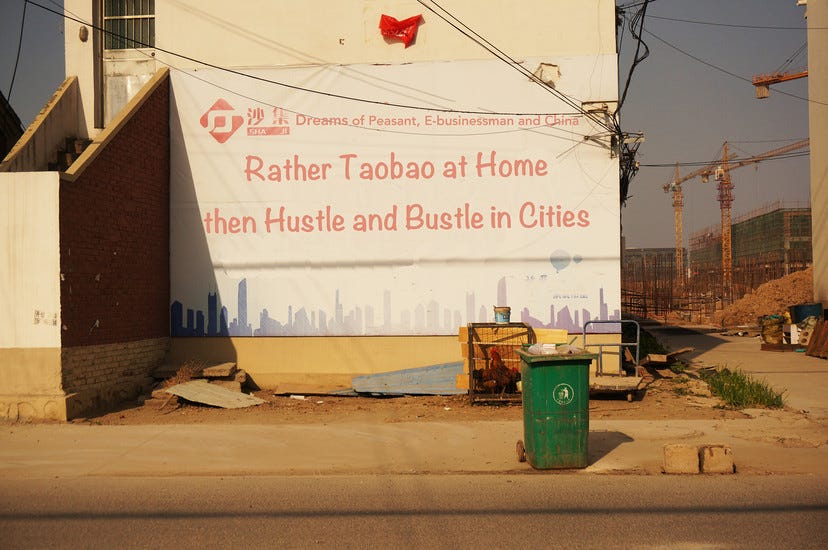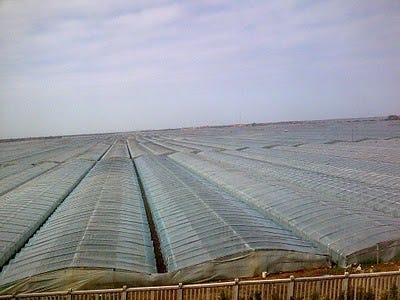This newsletter uses the STEEP framework to cover social, technological, ecological, economic, and political issues in an effort to provide a holistic view of the forces & patterns shaping our current reality.
I recently visited the “Countryside, the Future” exhibit by Rem Koolhaus at the Guggenheim. It was… dense. But also, mindblowing to see how the idea of “countryside” has changed over time, all over the world.
What does “countryside” mean right now? For some folks, 2020 has been an invitation to re-evaluate priorities and re-think how we want to live (urban? non-urban?). What does life even look like outside of urban centers?
There is much diversity to “village life” and aspects of urban life are making their way into smaller, more rural communities. The exhibit showcases 4 vignettes of modern villages in China that caught my attention.
The 4 communities are:
Fong Deng: a rural village completely transformed by an e-commerce platform (Society, Technology, Economy, Politics)
Yubulu: a village rebuilt for tourists to alleviate poverty and introduce social mixing (Society, Economy, Politics)
Shouguang: a greenhouse city, where families lease land to feed the rest of the country (Economy, Ecology, Politics)
Liuzhang: one of the last Maoist Communist strongholds where everyone is paid equally and no stores are allowed (Society, Economy, Politics)
Is there anything in these villages that you’d like to emulate?
P.S. If you can’t visit the exhibit but want to experience it, you can get the exhibit book.
Fong Deng “Tao Bao” Village

What is a “TaoBao village”?
Taobao.com is a platform for local producers to set up e-commerce shops. It is part of Alibaba (China’s cross between Amazon and E-bay).
The Chinese government considers a village to be a “TaoBao village” if collective e-commerce earnings from the platform are at least $1.4m dollars. “TaoBao villages” receive subsidies for training, marketing, and expanded infrastructure. On top of government funding, AliResearch has a rural development arm with ~$1b funding.
The technology and accompanying government policy have transformed the societies and economies of 4,000 villages in China.
How has Dong Feng economy transformed, now that it’s a “TaoBao” village?
Dong Feng village used to focus on pig breeding and trash recycling. After three villagers went to IKEA in Shanghai, they decided to open up their own furniture e-commerce store, inspired by IKEA’s flat pack efficiency.
Producers in the village use the TaoBao platform to sell goods and also use the Aliwangwang messaging app to chat with shoppers about how to customize their orders. It’s an on-demand one-stop-shop for furniture.
Dong Feng village has been completely transformed. Many villagers started building factories attached to their homes, since all organization, production, storage, and distribution is done from the countryside.
What does it feel like to live in a “TaoBao village”?
The social fabric has changed as migration patterns have changed due to a desire for community based living. Those from the countryside no longer have to move to cities for economic opportunity, and can instead migrate to smaller cities close to where they grew up. Pro e-commerce slogans are plastered on buildings throughout the village, like “To be rich, e-commerce leads the way. Put down the hoe, pick up the mouse,” or “Rather TaoBao at home then hustle and bustle in the cities”.
Economic opportunity offers greater gender equality (another slogan reads: “Women are powerful, Busy with business”). However, the social dynamic frays as competition increases and villagers start to copy one another’s products to offer at lower prices.
Yubulu Tourist Village

What is a tourist village?
The government invests in art-works and artist residencies to create points of interest and sponsors training for farmers to learn how to provide guest services. Tourists can stay with villagers by booking through Chinese Airbnb-like platforms.
Why has this village been transformed?
This transformation is part of the Chinese government’s rural revitalization plan, aimed at poverty alleviation. Villages are torn down and rebuilt for a specific purpose. Government poverty alleviation programs started in the 70’s and have helped 800 million people climb out poverty.
Shouguang Greenhouse City

Why is there a greenhouse village?
Given that only 7% of China’s landmass is suitable for farming, the Chinese government has invested in greenhouses to produce vegetables. Shouguang produces 5% of the countries veg with only .0002 of the landmass.
This greenhouse village is right outside of an urban center with skyscrapers, accessibly by high-speed train from Beijing. It was built on top of an older village that was demolished in 2016.
How do land use rights work in China?
Land use rights look very different in China than they do in the US — namely because all of the land in China is public. It can only be leased (not owned). Families get leasing rights based on their size, but some families choose to rent their spot to other families.
Liuzhang Communist Village

What do villagers in Liuzhang do for work?
Currently, everyone in the village works for the pharmaceutical company in town, producing antibiotics. The chief economic driver of the village has changed roughly once a decade. The village’s leader, Shi Laihe, directed the shift from agriculture to industrial production (car horns and ice cream), and now to pharmaceuticals.
Competition in the pharmaceutical industry is hurting the village — tourism may be the next industry to tackle.
How are villagers compensated?
Every villager receives exactly the same compensation (although engineers enjoy a bit more prestige). Everyone gets $500 / month, a house, large TV and fast internet. Each family gets one pound of meat per head every five days and unlimited fruits and vegetables to eat.
Education and healthcare are free and each family takes one trip abroad per year.
What is the village’s relationship with consumerism?
There is only one vending machine in town and there are no stores allowed. There is no advertising anywhere. Some villagers have secret shops TaoBao e-commerce shops selling organic vegetables.
Villagers see nearby towns with hotels, shops, and luxury cars and this is starting to make some people jealous.
Are people content? Do villagers stick around?
There is a sense of community; for example, there are daily line dancing classes in the village. However, the environment can feel stifling to some. Although there is a Swiss-like referendum for decision making in the village, the power is concentrated in a few families. Young women are starting to leave the village.



